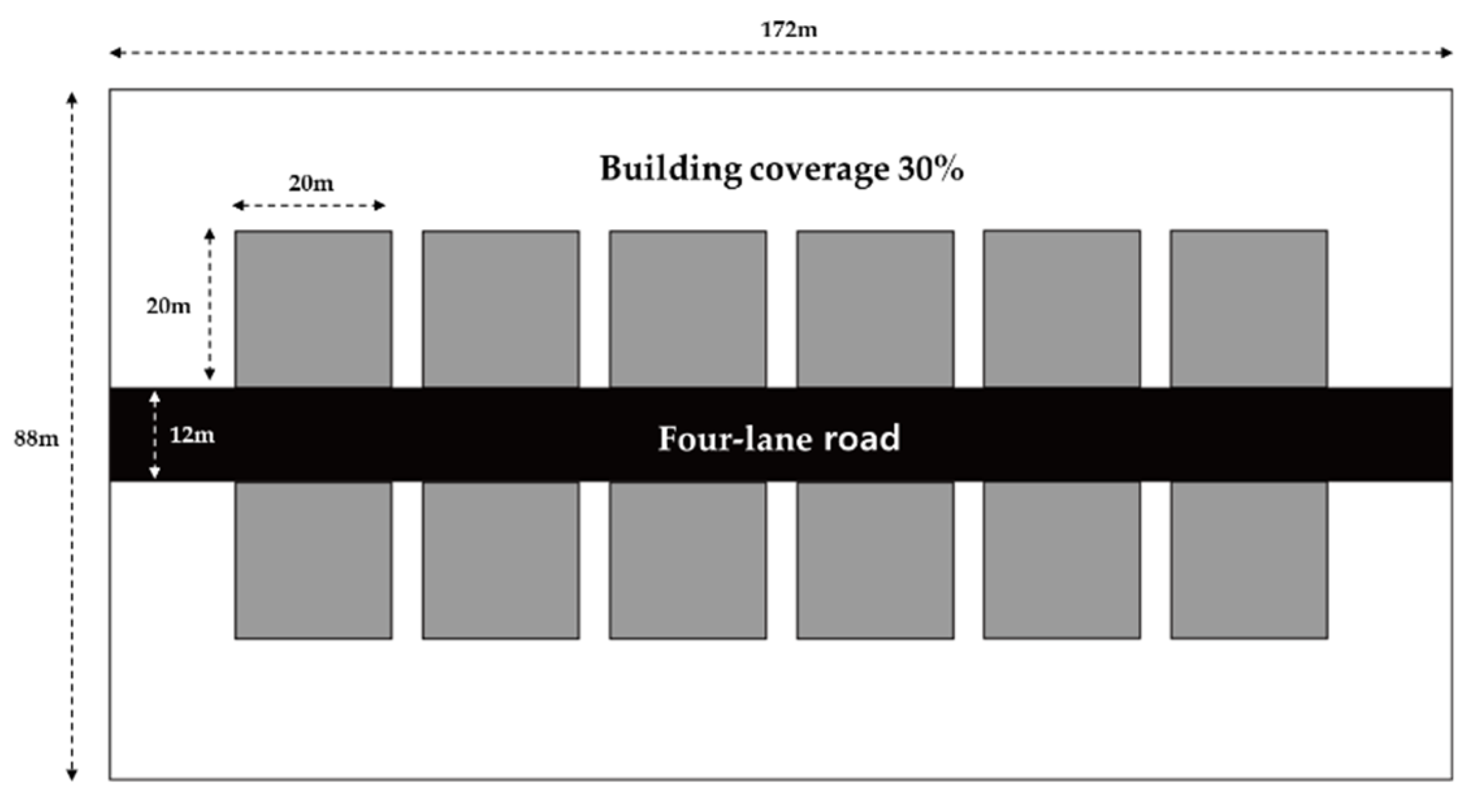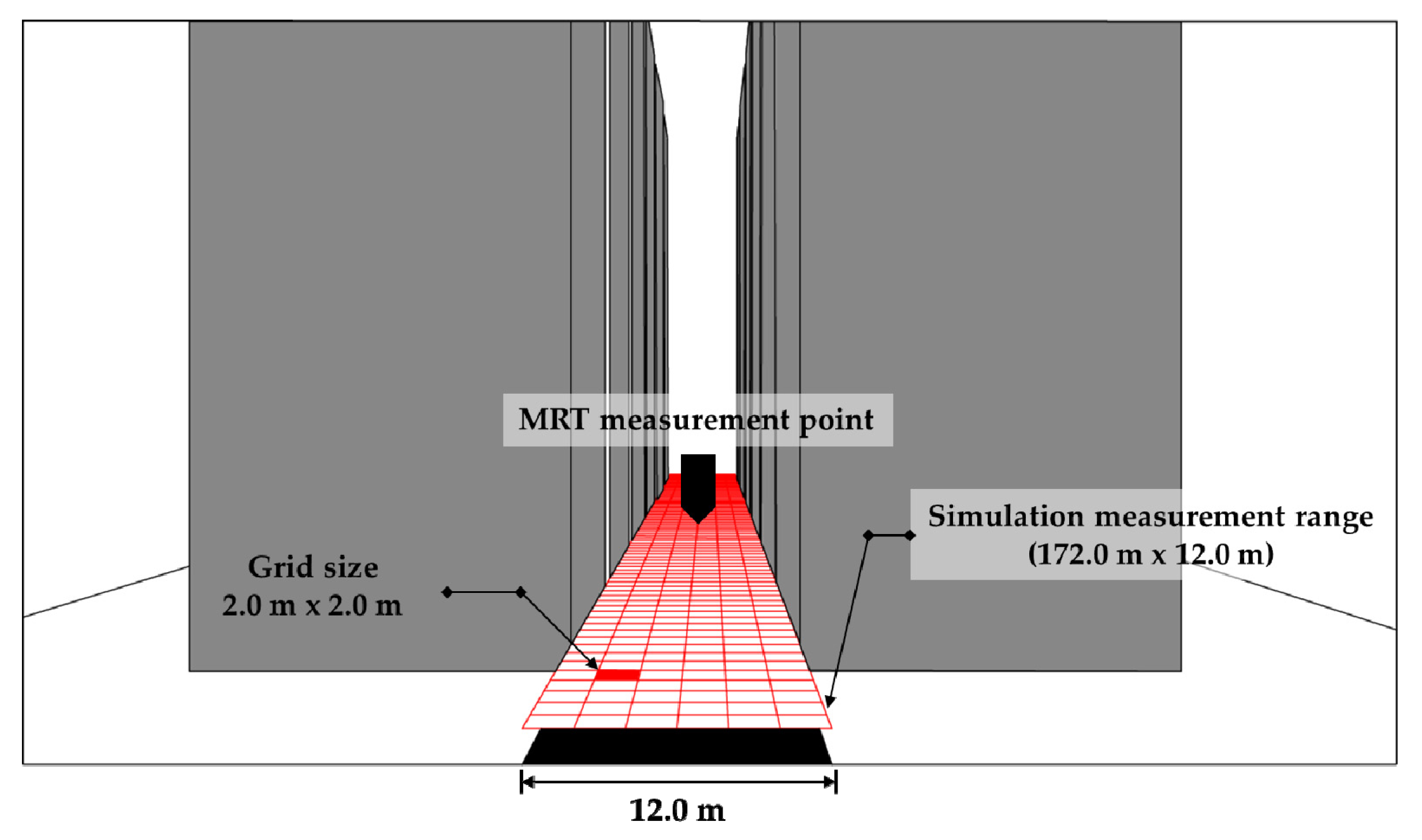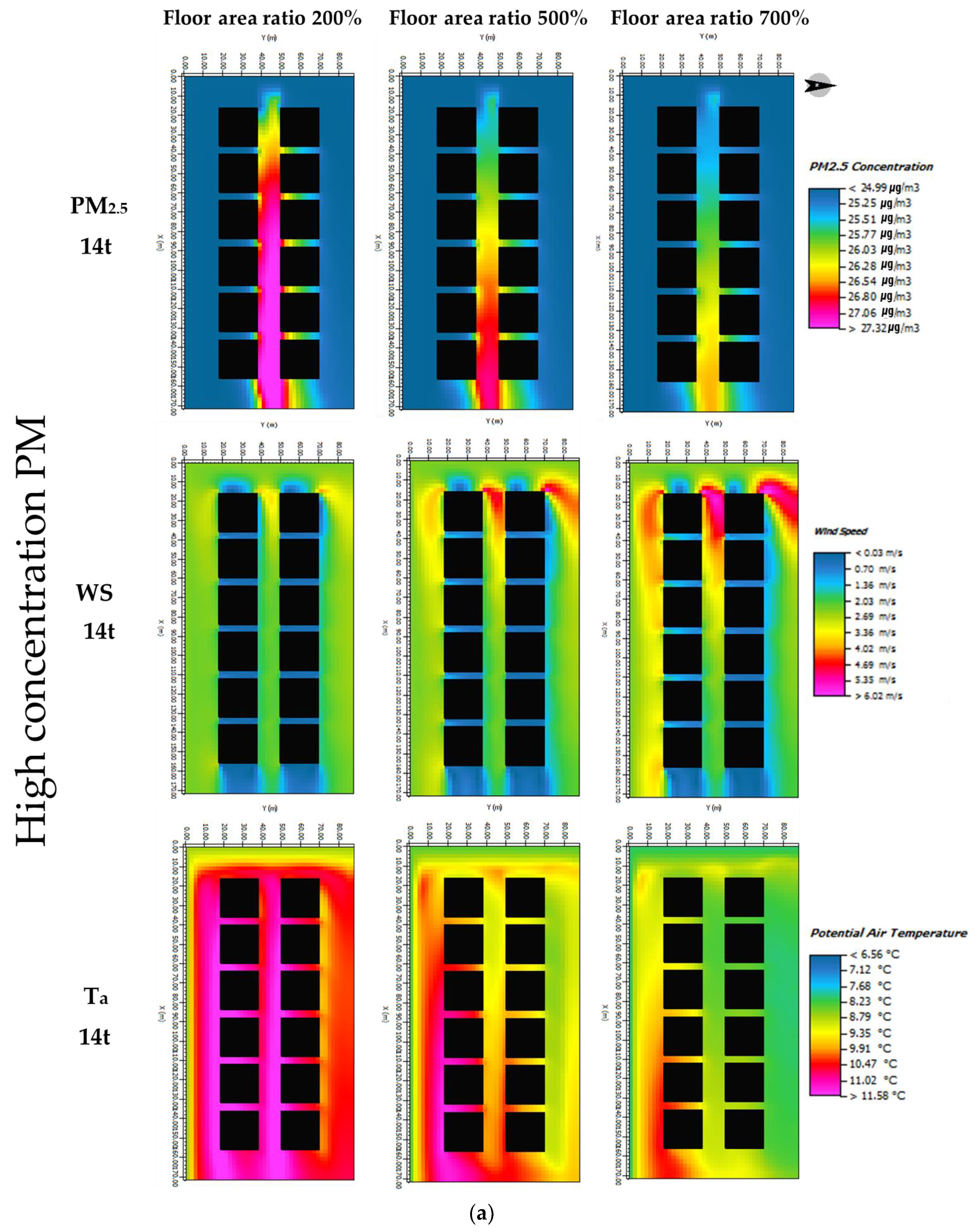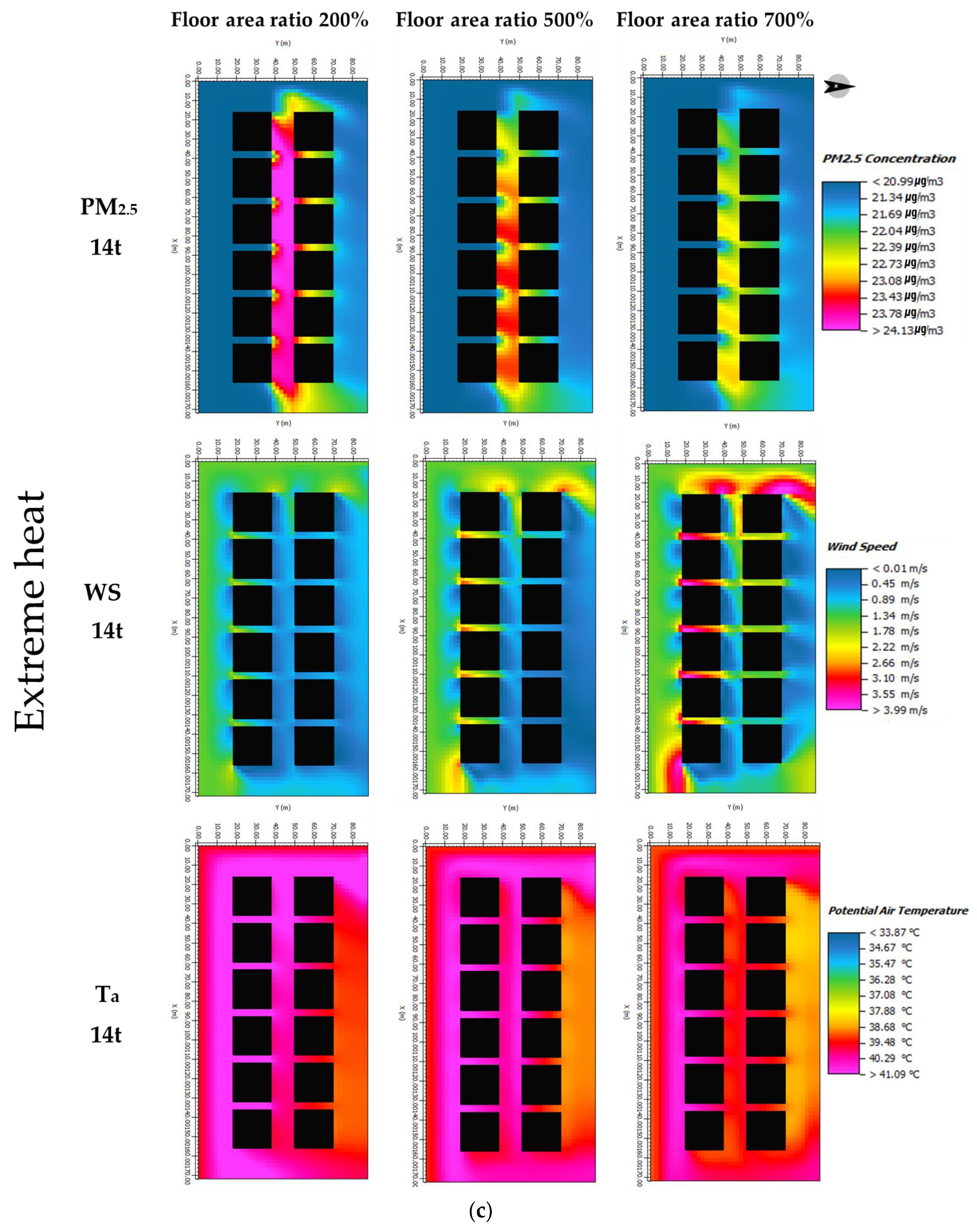Analysis of the Effects of Floor Area Ratio Change in Urban Street Canyons on Microclimate and Particulate Matter
Abstract
:1. Introduction
1.1. Background and Significance of Study
1.2. Previous Studies
1.3. Objective and Method of Study
2. Materials and Methods
2.1. 3D Microclimate Model
2.2. Simulation Conditions
2.3. Case Study
2.3.1. Conditions for Case Study
2.3.2. Case Model Overview
3. Results and Discussion
4. Conclusions
Author Contributions
Funding
Acknowledgments
Conflicts of Interest
Nomenclature
| Ta | atmospheric temperature [°C] |
| Tmrt | mean radiant temperature [°C] |
| Tsurface | surface temperature [°C] |
| WS | wind speed [m/s] |
| PM | particulate matter [μg/m3] |
References
- Heaviside, C.; Vardoulakis, S.; Cai, X.M. Attribution of mortality to the urban heat island during heatwaves in the West Midlands, UK. Environ. Health 2016, 15, 49–59. [Google Scholar] [CrossRef] [PubMed] [Green Version]
- Seungman, A.; Seungjong, K.; Hyeongchan, L. A Study on the Urban Area Microclimate Management Direction; Korea Research Institute for Human Settlements (KRIHS): Anyang, South Korea, 2016. [Google Scholar]
- Yongseok, S. Development of Risk Evaluation of Cold Wave for Vulnerable Population; Disaster Management Research Center (DMRC): Nagoya, Japan, 2019. [Google Scholar]
- Kwok, J.H.; Kim, H.S.; Woo, S.J.; Lee, S.H. Physical characterization of traffic-generated PM10 and PM2.5. Korean Soc. Atmos. Environ. 2012, 51, 45. [Google Scholar]
- Jonsson, P.; Bennet, C.; Eliasson, I.; Selin Lindgren, E. Suspended particulate matter and its relations to the urban climate in Dar es Salaam, Tanzania. Atmos. Environ. 2004, 38, 4175–4181. [Google Scholar] [CrossRef]
- Stone, B., Jr. Urban Heat and Air Pollution. J. Am. Plan. Assoc. 2005, 71, 13–25. [Google Scholar] [CrossRef]
- Li, L.J.; Wang, Y.; Zhang, Q.; Yu, T.; Zhao, Y.; Jin, J. Spatial distribution of aerosol pollution based on MODIS data over Beijing, China. J. Environ. Sci. 2007, 19, 955–960. [Google Scholar] [CrossRef]
- Menglin, S.J.; Wittaya, K.; Gary, P. Satellite-Observed Urbanization Characters in Shanghai, China: Aerosols, Urban Heat Island Effect, and Land–Atmosphere Interactions. Reomote Sens. 2011, 3, 83–99. [Google Scholar]
- Puneeta, P.; Dinesh, K.; Amit, P.; Jamson, M.; Manoj, S.; Surendra, K.; Vinod, K.J.; Krishan, K. A study of urban heat island and its association with particulate matter during winter months over Delhi. Sci. Total Environ. 2012, 414, 494–507. [Google Scholar]
- Sarrat, C.; Lemonsu, A.; Masson, V.; Guedalia, D. Impact of urban heat island on regional atmospheric pollution. Atmos. Environ. 2006, 40, 1743–1758. [Google Scholar] [CrossRef]
- Li-Wei, L.; Wan-Li, C. Air quality influenced by urban heat island coupled with synoptic weather patterns. Sci. Total Environ. 2009, 407, 2724–2733. [Google Scholar]
- Ali-Toudert, F.; Mayer, H. Numerical study on the effects of aspect ratio and orientation of an urban street canyon on outdoor thermal comfort in hot and dry climate. Build. Environ. 2006, 41, 94–108. [Google Scholar] [CrossRef]
- Fahmy, M.; Sharples, S. On the development of an urban passive thermal comfort system in Cairo, Egypt. Build. Environ. 2009, 44, 1907–1916. [Google Scholar] [CrossRef]
- Maggiotto, G.; Buccolieri, R.; Santo, M.A.; Leo, L.S.; Di Sabatino, S. Validation of temperature-perturbation and CFD-based modelling for the prediction of the thermal urban environment: The Lecce (IT) case study. Environ. Model. Softw. 2014, 60, 69–83. [Google Scholar] [CrossRef]
- Yang, X.; Zhao, L.; Bruse, M.; Meng, Q. Evaluation of a microclimate model for predicting the thermal behavior of different ground surfaces. Build. Environ. 2013, 60, 93–104. [Google Scholar] [CrossRef]
- Hofman, J.; Samson, R. Biomagnetic monitoring as a validation tool for local air quality models: A case study for an urban street canyon. Environ. Int. 2014, 70, 50–61. [Google Scholar] [CrossRef]
- Krüger, E.L.; Minella, F.O.; Rasia, F. Impact of urban geometry on outdoor thermal comfort and air quality from field measurements in Curitiba, Brazil. Build. Environ. 2011, 46, 621–634. [Google Scholar] [CrossRef]
- Morakinyo, T.E.; Lam, Y.F.; Hao, S. Evaluating the role of green infrastructures on near-road pollutant dispersion and removal: Modelling and measurement. J. Environ. Manag. 2016, 182, 595–605. [Google Scholar] [CrossRef]
- Nikolova, I.; Janssen, S.; Vos, P.; Vrancken, K.; Mishra, V.; Berghmans, P. Dispersion modelling of traffic induced ultrafine particles in a street canyon in Antwerp, Belgium and comparison with observations. Sci. Total Environ. 2011, 412–413, 336–343. [Google Scholar] [CrossRef]
- Wania, A.; Bruse, M.; Blond, N.; Weber, C. Analysing the influence of different street vegetation on traffic-induced particle dispersion using microscale simulations. J. Environ. Manag. 2012, 94, 91–101. [Google Scholar] [CrossRef]
- Morakinyo, T.E.; Lam, Y.F. Simulation study of dispersion and removal of particulate matter from traffic by road-side vegetation barrier. Environ. Sci. Pollut. Res. 2016, 23, 6709–6722. [Google Scholar] [CrossRef]
- Samaali, M.; Courault, D.; Bruse, M.; Olioso, A.; Occelli, R. Analysis of a 3D boundary layer model at local scale: Validation on soybean surface radiative measurements. Atmos. Res. 2007, 85, 183–198. [Google Scholar] [CrossRef]
- Chow, W.T.L.; Pope, R.L.; Martin, C.A.; Brazel, A.J. Observing and modeling the nocturnal park cool island of an arid city: Horizontal and vertical impacts. Theor. Appl. Climatol. 2011, 103, 197–211. [Google Scholar] [CrossRef]
- Chow, W.T.L.; Brazel, A.J. Assessing xeriscaping as a sustainable heat island mitigation approach for a desert city. Build. Environ. 2012, 47, 170–181. [Google Scholar] [CrossRef]
- Ng, E.; Chen, L.; Wang, Y.; Yuan, C. A study on the cooling effects of greening in a high-density city: An experience from Hong Kong. Build. Environ. 2012, 47, 256–271. [Google Scholar] [CrossRef]
- Rui, L.; Buccolieri, R.; Gao, Z.; Ding, W.; Shen, J. The Impact of Green Space Layouts on Microclimate and Air Quality in Residential Districts of Nanjing, China. Forests 2018, 9, 224. [Google Scholar] [CrossRef] [Green Version]
- Fu, X.; Liu, J.; Ban-Weiss, G.A.; Zhang, J.; Huang, X.; Ouyang, B.; Popoola, O.; Tao, S. Effects of canyon geometry on the distribution of traffic-related air pollution in a large urban area: Implications of a multi-canyon air pollution dispersion model. Atmos. Environ. 2017, 165, 111–121. [Google Scholar] [CrossRef]
- Oke, T.R.; Mills, G.; Voogt, A. Urban Climates; Cambridge University Press: Cambridge, UK, 2017; p. 546. [Google Scholar]
- Bourbia, F.; Boucheriba, F. Impact of street design on urban microclimate for semi arid climate. Renew. Energy 2010, 35, 343–347. [Google Scholar] [CrossRef]
- Giridharan, R.; Lau, S.S.Y.; Ganesan, S.; Givoni, B. Urban design factors influencing heat island intensity in high-rise high-density environments of Hong Kong. Build. Environ. 2007, 42, 3669–3684. [Google Scholar] [CrossRef]








| Simulation Periods | High-Concentration PM | Extreme Heat | Extreme Cold | |
|---|---|---|---|---|
| Variable | ||||
| Start simulation at day (DD.MM.YYYY) | 06.04. 2018 | 01.08. 2018 | 24.01. 2016 | |
| Start simulation at time (HH:MM:SS) | 00:00:00 | |||
| Total simulation time (h) | 24 | |||
| Wind speed measured in 10 m height (m/s) | 3.0 | 1.7 | 3.2 | |
| Wind direction (deg) (0 = from North…180 = from South) | 255.4 | 214.0 | 321.3 | |
| Roughness length at measurement site | 0.1 | |||
| Initial temperature of atmosphere (°C) | 7.2 | 30.5 | −16.0 | |
| Relative humidity in 2 m (%) | 74.0 | 55.8 | 47.0 | |
| Variable | ||
|---|---|---|
| Type of Street Segment | Inner-Urban Road | |
| Daily traffic value (Veh/24 h) | 48,884 | |
| Number of lanes in this street segment | 4 | |
| Contribution of vehicle category to overall traffic in percent (%) | Light duty vehicles | 59.0 |
| Heavy duty vehicles | 24.5 | |
| Motocycles | 12.2 | |
| Public transport | 0.2 | |
| Coaches | 0.1 | |
| Passenger cars | 3.1 | |
| Result | Particulate Matter (PM) Factors | Microclimate Factors | |||||||||
|---|---|---|---|---|---|---|---|---|---|---|---|
| PM2.5 | PM10 | O3 | NO2 | NOx | Ta | Tmrt | Tsurface | WS | |||
| Factors | |||||||||||
| Floor area ratio | High -concentration PM | −0.971 ** | −0.973 ** | −0.932 ** | −0.949 ** | −0.968 ** | −0.680 ** | −0.801 ** | −0.782 ** | 0.980 ** | |
| 0.000 | 0.000 | 0.000 | 0.000 | 0.000 | 0.005 | 0.000 | 0.001 | 0.000 | |||
| Extreme heat | −0.418 | −0.417 | −0.50 | −0.331 | −0.399 | −0.164 | −0.655 ** | −0.682 ** | 0.924 ** | ||
| 0.121 | 0.122 | 0.860 | 0.228 | 0.140 | 0.560 | 0.008 | 0.005 | 0.000 | |||
| Extreme cold | −0.923 ** | −0.927 ** | 0.008 | −0.924 ** | −0.924 ** | −0.237 | −0.245 | −0.394 | 0.711 ** | ||
| 0.000 | 0.000 | 0.978 | 0.000 | 0.000 | 0.395 | 0.378 | 0.146 | 0.003 | |||
 Correlation coefficient;
Correlation coefficient;  Significance probability; p * < 0.05, p ** < 0.01; p: Significance level.
Significance probability; p * < 0.05, p ** < 0.01; p: Significance level.| Particulate Matter (PM) Factors | ||||||
|---|---|---|---|---|---|---|
| PM2.5 | PM10 | O3 | NO2 | NOx | ||
| Microclimate factors | Ta | 0.646 ** | 0.649 ** | 0.789 ** | 0.591 * | 0.638 * |
| 0.009 | 0.009 | 0.000 | 0.020 | 0.010 | ||
| Tmrt | 0.765 ** | 0.762 ** | 0.925 ** | 0.700 ** | 0.755 ** | |
| 0.001 | 0.001 | 0.000 | 0.004 | 0.001 | ||
| Tsurface | 0.730 ** | 0.732 ** | 0.902 ** | 0.665 ** | 0.721 ** | |
| 0.002 | 0.002 | 0.000 | 0.007 | 0.002 | ||
| WS | −0.960 ** | −0.964 ** | −0.916 ** | −0.940 ** | −0.957 ** | |
| 0.000 | 0.000 | 0.000 | 0.000 | 0.000 | ||
 Correlation coefficient;
Correlation coefficient;  Significance probability; p * < 0.05, p ** < 0.01; p: Significance level.
Significance probability; p * < 0.05, p ** < 0.01; p: Significance level.Publisher’s Note: MDPI stays neutral with regard to jurisdictional claims in published maps and institutional affiliations. |
© 2021 by the authors. Licensee MDPI, Basel, Switzerland. This article is an open access article distributed under the terms and conditions of the Creative Commons Attribution (CC BY) license (http://creativecommons.org/licenses/by/4.0/).
Share and Cite
Jung, S.; Yoon, S. Analysis of the Effects of Floor Area Ratio Change in Urban Street Canyons on Microclimate and Particulate Matter. Energies 2021, 14, 714. https://doi.org/10.3390/en14030714
Jung S, Yoon S. Analysis of the Effects of Floor Area Ratio Change in Urban Street Canyons on Microclimate and Particulate Matter. Energies. 2021; 14(3):714. https://doi.org/10.3390/en14030714
Chicago/Turabian StyleJung, Sukjin, and Seonghwan Yoon. 2021. "Analysis of the Effects of Floor Area Ratio Change in Urban Street Canyons on Microclimate and Particulate Matter" Energies 14, no. 3: 714. https://doi.org/10.3390/en14030714
APA StyleJung, S., & Yoon, S. (2021). Analysis of the Effects of Floor Area Ratio Change in Urban Street Canyons on Microclimate and Particulate Matter. Energies, 14(3), 714. https://doi.org/10.3390/en14030714





